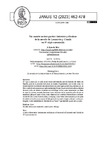Mostrar o rexistro simple do ítem
Un cuento en tres partes: intereses y técnicas de la novela de Leonardo y Camila en El viaje entretenido
| dc.contributor.author | Díez, J. Ignacio | |
| dc.date.accessioned | 2024-05-28T18:18:57Z | |
| dc.date.available | 2024-05-28T18:18:57Z | |
| dc.date.issued | 2023-12-11 | |
| dc.identifier.citation | Díez, J. Ignacio. «Un cuento en tres partes: intereses y técnicas de la novela de Leonardo y Camila en El viaje entretenido». JANUS. Estudios sobre el Siglo de Oro, n. 12, diciembre de 2023, pp. 462-478. DOI.org (Crossref), https://doi.org/10.51472/JESO20231219. | es_ES |
| dc.identifier.issn | 2254-7290 | |
| dc.identifier.uri | http://hdl.handle.net/2183/36686 | |
| dc.description.abstract | [Resumen] El viaje entretenido no solo proporciona información para la historia del teatro en España, pues en su peculiar estructura se inserta, fragmentada, una novela corta. La novela aparece dividida en tres partes dentro de una organización muy medida, en un libro donde la estructura es un rígido andamiaje. Rojas proyecta en la novela sus deseos de autor culto, en abierto contraste con el diálogo de los cuatro personajes que llena el viaje. La novela, además, funciona como descanso de la narración sobre la que se asienta el diálogo a cuatro voces, como relato escrito y retórico frente al tono conversacional del libro, como historia seria y compleja, como relato interrumpido que recupera el interés de los lectores cuando el diálogo entre los cuatro viajeros decae o se ha prolongado, como manifestación literaria de un “autor” que también quiere ser un autor. | es_ES |
| dc.description.abstract | [Abstract] El viaje entretenido not only provides information for the history of theater in Spain, but also, in its peculiar structure, a short and fragmented novel is inserted. The novel is divided into three parts within a very measured organization, in a book where the structure is a rigid scaffolding. Rojas projects in the novel his desires of a cultured author, in open contrast with the dialogue of the four characters that fills the journey. The novel also functions as a break in the narrative on which the four-voice dialogue is based, as a written and rhetorical story in contrast to the conversational tone of the book, as a serious and complex story, as an interrupted tale that recovers the readers' interest when the dialogue between the four traveler characters lapses or has been prolonged, as a literary manifestation of an "author" who also wants to be an author. | es_ES |
| dc.language.iso | spa | es_ES |
| dc.publisher | Universidade da Coruña, Servizo de Publicacións | es_ES |
| dc.relation.uri | https://doi.org/10.51472/JESO20231219 | es_ES |
| dc.rights | Atribución-NoComercial-SinDerivar 4.0 Internacional | es_ES |
| dc.rights.uri | https://creativecommons.org/licenses/by-nc-nd/4.0/deed.es | * |
| dc.subject | Novela | es_ES |
| dc.subject | Estructura | es_ES |
| dc.subject | Inserción | es_ES |
| dc.subject | Distribución | es_ES |
| dc.subject | Diálogo | es_ES |
| dc.subject | Novel | es_ES |
| dc.subject | Structure | es_ES |
| dc.subject | Insertion | es_ES |
| dc.subject | Distribution | es_ES |
| dc.subject | Dialogue | es_ES |
| dc.title | Un cuento en tres partes: intereses y técnicas de la novela de Leonardo y Camila en El viaje entretenido | es_ES |
| dc.title.alternative | A Tale in Three Parts: Interests and Techniques of the Novel of Leonardo and Camila in El viaje entretenido | es_ES |
| dc.type | info:eu-repo/semantics/article | es_ES |
| dc.rights.access | info:eu-repo/semantics/openAccess | es_ES |
| UDC.journalTitle | JANUS. Estudio sobre el Siglo de Oro | es_ES |
| UDC.volume | 12 | es_ES |
| UDC.startPage | 462 | es_ES |
| UDC.endPage | 478 | es_ES |






